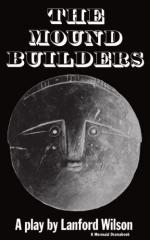2. Horn Implements. (See D. Figure 1.) The only implement of this class that we have yet found is the fish spear head (Fig. D.). It was probably made from the antlers of a deer killed in the chase. Its barbed edge indicates that it was used for spearing fish. It is in a fair state of preservation.
3. Copper. No discovery of the mounds so fills the mind of the Archaeologist with joy as that of copper implements. Copper mining has now by the discovery in the Lake Superior region, of mining shafts long deserted, in which copper was quarried by stone hammers on a large scale, been shown to have been pursued in very ancient times on this continent. It is of intense interest for us to know that not only are there mines found on the south side of Lake Superior, but also at Isle Royale, on the north side just at the opening of Thunder Bay, and immediately contiguous to the Grand Portage, where the canoe route to Rainy River, so late as our own century, started from Lake Superior. According to the American Geologists the traces for a mile are found of an old copper mine on this Island. One of the pits opened showed that the excavation had been made in the solid rock to the depth of nine feet, the walls being perfectly smooth. A vein of native copper eighteen inches thick was discovered at the bottom. Here is found also, unless I am much mistaken, the mining location whence the Takawgamis of Rainy River obtained their copper implements. Two copper implements are in our possession, one found by Mr. E. McColl in the grand mound, and the other by Mr. Alexander Baker in a small mound adjoining this.
(a.) Copper Needle or Drill. (See A. Fig. 1.) This was plainly used for some piercing or boring purpose. It is hard, yields with difficulty to the knife, and is considered by some to have been tempered. It may have been for drilling out soft stone implements, or was probably used for piercing as a needle soft fabrics of bark and the like, which were being sewed together.
(b.) Copper Cutting Knife. (See E. Fig. 1.) This, has evidently been fastened into a wooden handle. It may have been used for cutting leather, being in the shape of a saddler’s knife, or was perhaps more suited for scraping the hides and skins of animals being prepared for use.




